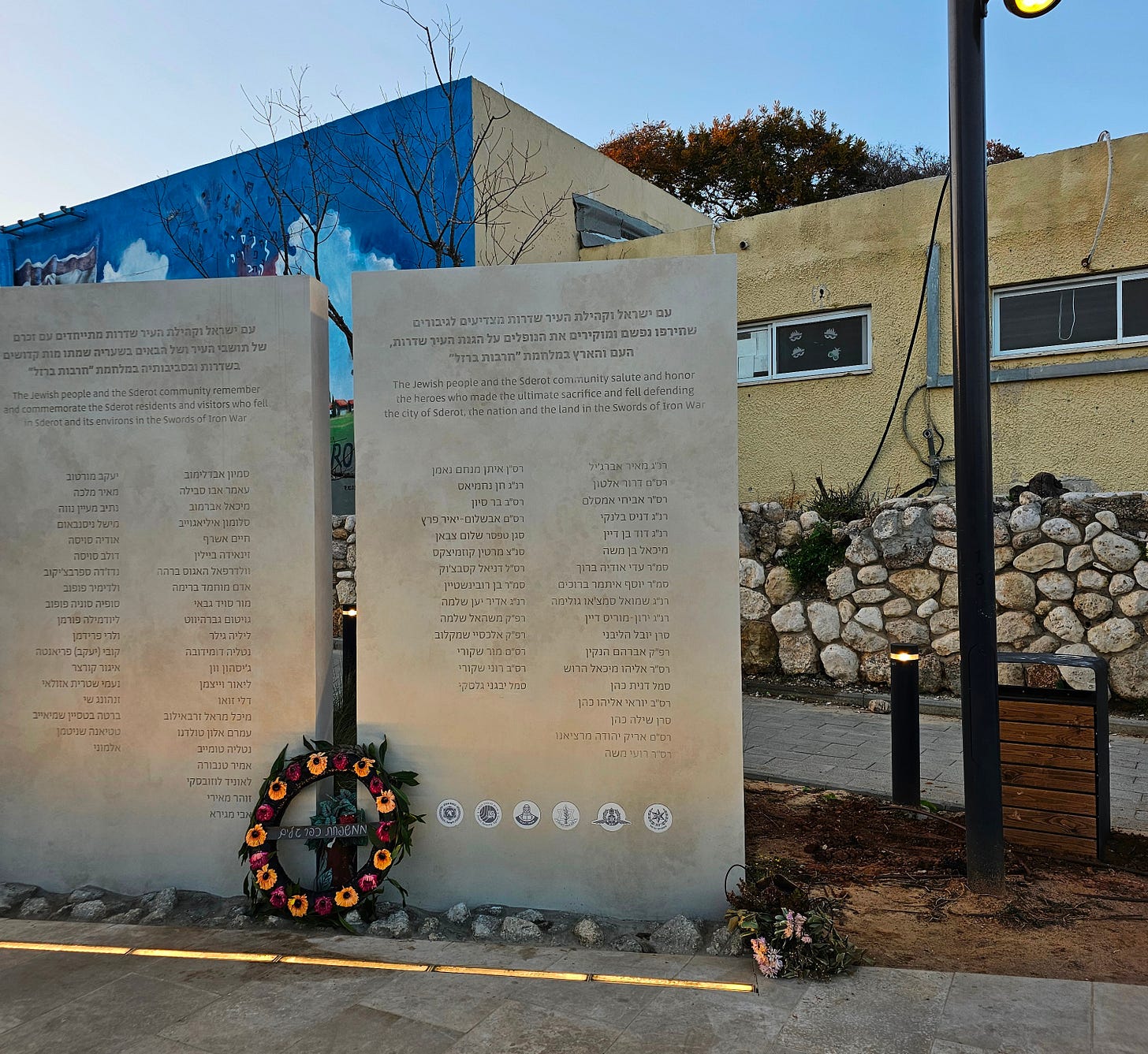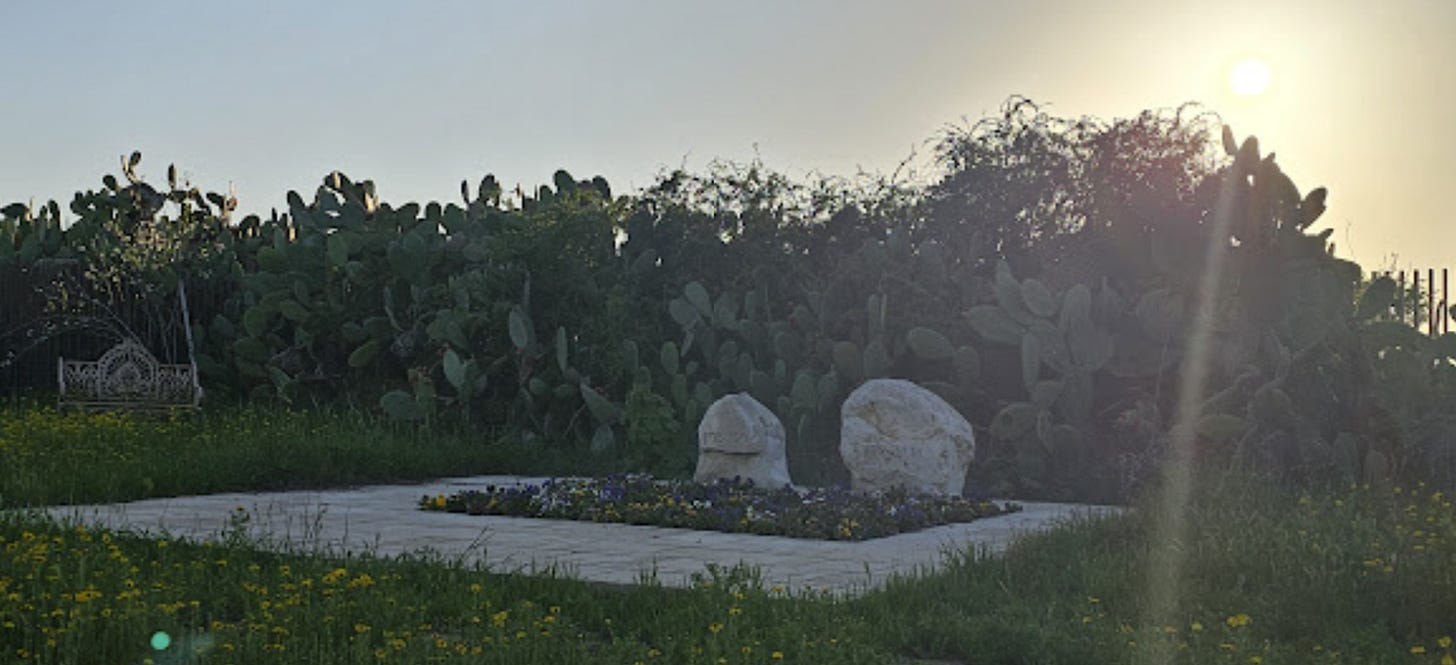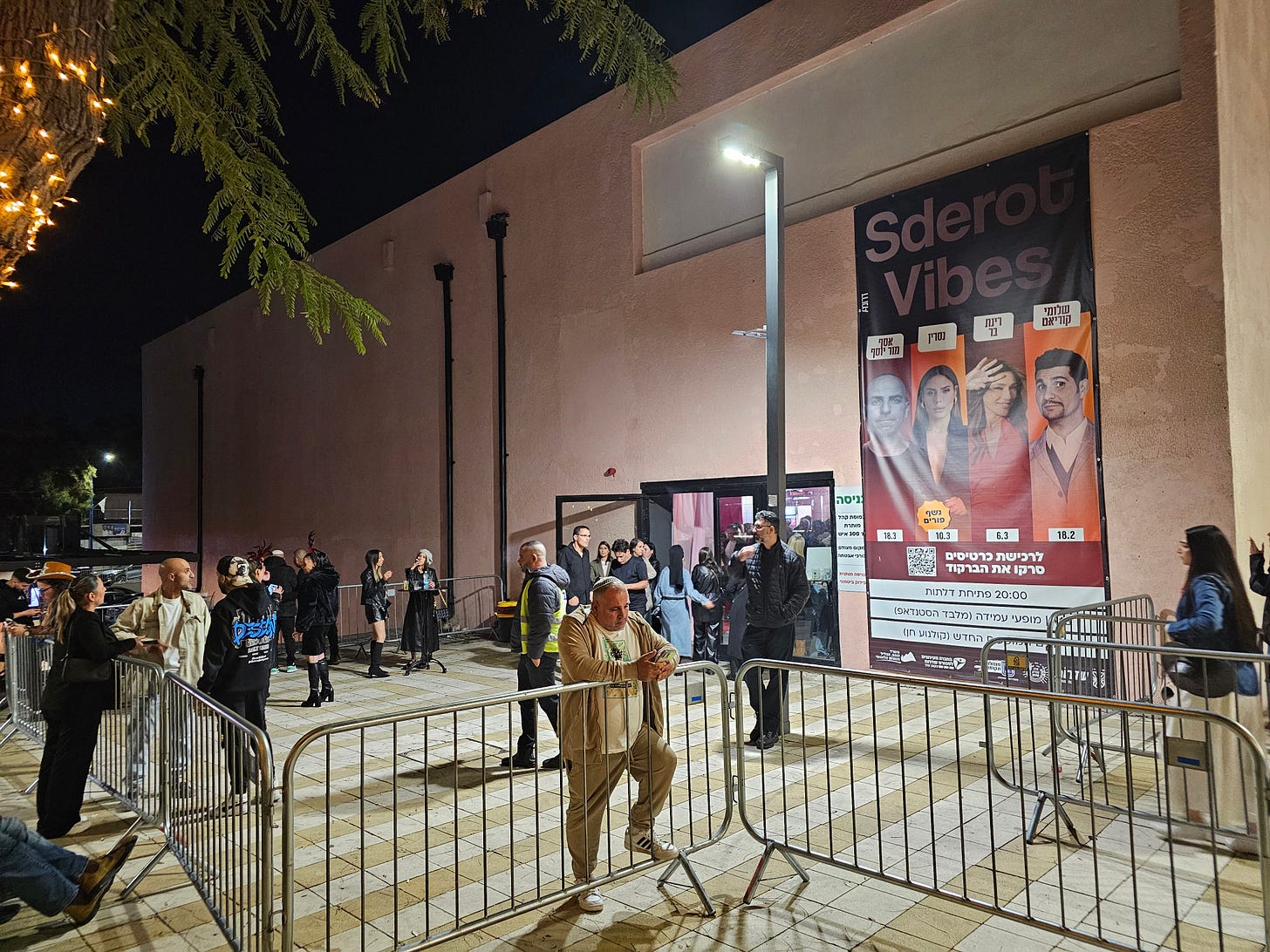I arrived in Israel today.
I’ve rewritten this sentence about 15 times because I don’t know how to begin, but I’ll start with this: I’m confused.
I don’t know how to feel. I don’t know if I should be excited to be back “home” which I definitely am, or sad because of the circumstances of the visit. As I sit in Sderot this evening, however, literally hearing fighter jets flying overhead, I realize that it may take some time to process my feelings, so let me start, rather, with what I saw.
I was picked up from the airport by a cousin - Nadav - and we immediately made our way south. I’ve been to Israel many times before, and I usually head in one of three directions from the airport: west to Tel Aviv, north to Petach Tikva (where my aunt lives), or east to Jerusalem. But never south. Today however, I traveled in a new direction, and it made me feel as though I was visiting an Israel I’ve never seen before because, well, on that route, I was seeing an Israel I’ve never seen before.
The fields this time of year are a dark and lush green. Green as far as you can see, and rather than seeing a new town, city, or settlement over each subsequent hill, it felt like the further we drove, the more open space there was. It made me realize how big this small country can sometimes feel, and, candidly, it made me think: “Well, if more Jews need to make Israel their home, at least there’s still lots of land available.”
Nadav mentioned at one point that we were nearing the Sharon Ranch, a huge tract of land that Ariel Sharon owned, and where he is buried. Wanting to stretch my legs after a long flight, I asked if we could pull over, and we took a quick walk to see where Israel’s 11th prime minister is buried. Unlike many of Israel’s leaders buried on Har Herzl in Jerusalem, Ariel Sharon is buried next to his wife Lili on a small plot on a hill overlooking their ranch in the northwest Negev. He was an outdoorsman and loved nature, and it seemed a fitting place for him to rest.
And maybe, while making my way to Sderot, on day 521 of this war, Sharon’s grave was an important first stop. In some respects, perhaps we would not be here if not for Sharon’s fateful decision to unilaterally withdraw Israelis from Gaza 20 years ago (this August), ending Israeli military rule of Gaza, and laying the groundwork for a 2007 Hamas takeover of Gaza. On the one hand, maybe Sharon made an error turning Gaza over to the Palestinians for self-rule. On the other hand, perhaps he set in motion the ultimate cautionary tale: how could Israelis ever possibly consider handing the West Bank over to the Palestinians when they see how Gaza was turned into a massive centre for directing terror attacks against Israeli civilians?
After our pitstop, we made our way into Sderot. Nadav lamented to me on the drive that in some respects living in Sderot felt, nowadays, like living in Auschwitz. Its a crude analogy, but not altogether wrong. It’s not just that Sderot had become one massive memorial site, but it has also become a disaster-tourism site, with tourists appearing all day by the busload. Though at first his comparison with Auschwitz caught me off guard, having spent the last few hours here, I can certainly agree in some respects with the comparison.
Entering Sderot, you are immediately struck by the signs and the yellow. Everywhere. Signs on the fences and the lightposts. On the bridges and the bus stops. Yellow ribbons, and posters, and flags. Everywhere there are pictures of the dead and missing, and signs seeking to bring them home. “Beyachad Nenatzeach” (together we will win), or signs that say “The war isn’t over until everyone is home,” or some variation of the same. There are signs everywhere. There’s graffiti everywhere. There’s anger everywhere. It is clear, to any objective observer, that something awful happened - and is still happening - here. Sderot is not just a place where something bad happened 521 days ago - it is very much an open wound, where families mourn their loved ones who are missing over the border - really not that far from here at all, just 1km away - or those still mourning the utter intelligence and military failure of that fateful day.
Driving through the main roundabout, and into town, the sides of the road are dotted with memorials. We turned onto Route 232, now notorious street in 10/7 lore where so much death and destruction occurred. 521 days ago, Hamas terrorists killed and maimed as many Israelis as they could on Route 232, and bodies spilled out along the sides of the road, while people sought to get to safety, to hide from the carnage of the day. These included those fleeing their homes in Sderot, the Nova Festival in Reim, and other local moshavim and kibbutzim, when the attacks began.
We drove past the roundabout where Romi and Lia Suissa (6 and 3, respectively) were discovered in their parents’ car by an Israeli police officer. Their parents had been killed in front of them by Hamas terrorists, and these two young girls hid in the car until they were rescued. When a police officer opened the door and saw the two girls cowering there, six-year-old-Romi asked him, “Are you with Israel?” as she was taken to safety. Today, these orphans are now 7 and 4. 521 days without their parents.

It was hard to take in everything, to realize that unlike Auschwitz, Sderot is a living and breathing place, where people still live and work, raise families and make memories, in among the hearbreak and ruin, and next to those memorials and unhealed wounds.
We stopped at what is now a beautiful new memorial site but what was once the site of Sderot’s main police station, reduced to rubble on 10/7. The brand new memorial there is a stark reminder of what once stood, and there are two lists next to the site: the names of those police officers who died defending the building and the town that day, and another list of those inhabitants of Sderot who lost their lives that same morning.

It was - and remains - uncomfortable, being a participant on this disaster-tourism journey. I don’t like it, but at the same time, feel it is important to bear witness to what happened, and to see with your own eyes so much that you’ve heard about in the past. But there is definitely something inappropriate and uncomfortable about the tourism-element to it.
For example, as we stood looking at the police station memorial, a bus pulled up, and a group of Israeli tourists jumped out to see. Some of them gathered around their guide for an explanation, while others posed for pictures. Smiling and posing next to a memorial to a massacre that, in the grand scheme of things, literally just happened, was really strange. It’s like smiling under the Arbeit Macht Frei sign at Auschwitz, or posing with your loved one, flashing the peace sign with your fingers, at the Berlin Holocaust Memorial. It is a strange dissonance, especially when the memorialized events LITERALLY JUST HAPPENED. But hey, these are just my observations, as judgy as they may sound.
Later in the evening, we went out for dinner and walked around the “downtown” of Sderot. A few years ago, the town tried to gentrify itself a bit more, with a small pedestrian walkway, a pub, some outdoor dining areas, and a renovated theatre. I understand some of these efforts were put on hold after 10/7, as other efforts became more pressing. One cannot walk around here without being struck by how many bomb shelters there are, and the need for every building to be fortified in some way. It’s not normal.
Nonetheless, tonight, at the “Sderot Vibes” festival, there was a Purim party and concert by Israeli singer Nasrin. Some young Sderotniks were dressed up in costumes, milling around, waiting for the show to begin. I walked past in my Roots-flannel, protected against the cool of the early-March-evening, wondering what horrors these people have seen, and what they do each night to forget it, as they close their eyes to sleep.
I realize from these observations that I must sound like the ultimate outsider. A naive Canadian, traveling across the world to visit a war-zone, in Israel’s periphery, confused about how to feel. I started writing confused about my feelings here, so maybe this is how I should end:
This is not a story about me, but about the country that I know - or feel like I once knew - that grew up over the last 521 days to something I am having difficulty understanding. It looks and feels different, but it’s the same. The people helping me cut the customs line at Ben Gurion Airport because I speak Hebrew well for a “Kanadi,” the pull of family who you have not seen for years, and the sense that you are simply in a place where you belong. All of that makes Israel…Israel. And perhaps I should expect nothing less or more.
Will see what my full day in the Gaza Envelope tomorrow does for my feelings.







Thank you for sharing
I too felt like I was visiting another Aushwitz when we visited Sderot. When I saw the burnt out, piled up cars I was vividly reminded of the piles of shoes in Aushwitz.
Well written Ad